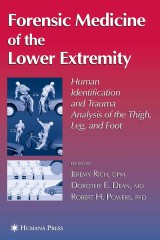Details

Forensic Medicine of the Lower Extremity
Forensic Science and Medicine
|
223,63 € |
|
| Verlag: | Humana Press |
| Format: | |
| Veröffentl.: | 28.10.2007 |
| ISBN/EAN: | 9781592598977 |
| Sprache: | englisch |
| Anzahl Seiten: | 438 |
Dieses eBook enthält ein Wasserzeichen.
Beschreibungen
Publius Syrus stated back in 42 B.C., “You cannot put the same shoe on every foot.” (Maxim 596) Though written long before the advent of forensic science, Syrus’ maxim summarizes the theme of Forensic Medicine of the Lower Extremity: Human Identification and Trauma Analysis of the Thigh, Leg, and Foot. Put simply, the lower extremity is a tremendously variable anatomic region. This variation is beneficial to forensic experts. Differences in the leg and foot can be used to establish individual identity. Analysis of damage to the lower limb can be used to reconstruct antemortem, perimortem, and postmortem trauma. As a forensic anthropologist, I analyze cases involving decomposed, burned, m- mified, mutilated, and skeletal remains. Many of the corpses I examine are incomplete. Occasionally, I receive nothing but the legs and feet; a lower torso dragged from a river; a foot recovered in a city park; dismembered drug dealers in plastic bags; victims of bombings and airline disasters; and the dead commingled in common graves. Though the leg and foot contain much that is useful in forensic analysis, before this publication, investigators faced a twofold problem. Little research that focused on the lower extremity was available in the literature, and the existing research was published in diverse sources, making its location and synthesis a daunting task.
Analysis, Development, and Identification Markers.- The Decomposition of Human Remains.- Forensically Significant Skeletal Anatomy.- Normal Osteology of the Knee Joint and Markers of Stress and Injury.- Anthropological Analysis of the Lower Extremity.- Estimating Age at Death.- Radiology of the Lower Extremity.- Trauma Analysis and Reconstruction.- Injuries to Children.- Skeletal Trauma Analysis of the Lower Extremity.- Biomechanics of Impact Injury.- Injuries of the Thigh, Knee, and Ankle as Reconstructive Factors in Road Traffic Accidents.- Biomechanical Analysis of Slip, Trip, and Fall Accidents.- Foot Identification Case Studies, Pedal Evidence, and Ongoing Research.- “The Game is Afoot!”.- The Role of Feet and Footwear in Medicolegal Investigations.- Ongoing Research Into Barefoot Impression Evidence.
The lower extremity is a tremendously variable anatomic region that can be used to establish individual identity, or, if damaged, can be used to reconstruct antemortem, perimortem, and postmortem trauma. In Forensic Medicine of the Lower Extremity: Human Identification and Trauma Analysis of the Thigh, Leg, and Foot, leading forensic authorities rigorously review both the scientific and practical aspects of human identification, trauma analysis, and biomechanics of lower extremity as encountered in decomposed or dismembered individuals, mass casualty situations, and human rights abuse investigations. On the scientific side, the authors describe the biochemical events of decomposition, detail the use of radiology to facilitate identification and evaluate trauma, and explain principles of osteology, with an emphasis on the implications for skeletal anatomy for age, sex, race, and height estimation. On the practical side, they apply these approaches to trauma analysis and accident reconstruction, including slip-and-fall incidents, impact, traffic, and pediatric injuries, and considerations of foot and footprint identification. Specific case studies discuss the identification process using the foot and ankle and illuminate the forensic potential of feet, footwear, and barefoot impression evidence.<BR>
Authoritative and copiously illustrated, Forensic Medicine of the Lower Extremity: Human Identification and Trauma Analysis of the Thigh, Leg, and Foot comprehensively reviews the basic process of forensic identification, trauma investigation, and accident reconstruction of the lower extremity.
Authoritative and copiously illustrated, Forensic Medicine of the Lower Extremity: Human Identification and Trauma Analysis of the Thigh, Leg, and Foot comprehensively reviews the basic process of forensic identification, trauma investigation, and accident reconstruction of the lower extremity.
Includes supplementary material: sn.pub/extras
This comprehensive collection of rigorous review articles covers both the scientific and practical aspects of using of lower extremity remains for human identification and trauma analysis. On the scientific side, the authors describe the biochemical events of decomposition, detail the use of radiology to facilitate identification and evaluate trauma, and explain principles of osteology, with an emphasis on the implications for skeletal anatomy for age, sex, race, and height estimation.
Diese Produkte könnten Sie auch interessieren:

Aktinische Keratosen - medizinisches Grundwissen und NEUE Therapieansätze (Carcinomata in situ)

von: Hellene von Waldgraben

9,99 €

Manual clínico de los antidepresivos

von: Victor R. Uriarte Bonilla, Victor R. Uriarte Editorial Alfil, S. A. de C. V.

23,99 €














